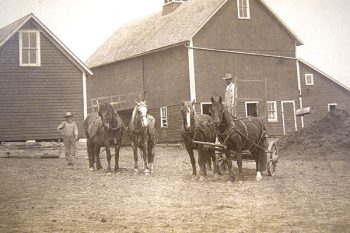
Topper, Trigger, Champion, Silver and Buttermilk were all television and movie stars in the 1940s-50s. They were horses, arguably as famous as their human riders (Hopalong Cassidy, Roy Rogers, Gene Autry, The Lone Ranger, Dale Evans). And there were the four-legged comic book heroes Thunder and Papoose transporting Red Ryder and Little Beaver. Before their exploits in media westerns, equines made valuable contributions to American life – Paul Revere’s Ride, native American culture on the plains and the settlement of southeast Minnesota.
Most Minnesota settlers of European heritage arrived, not with horses but with oxen, which were better suited for the working and traveling conditions of the mid-to-late 1800s. They better tolerated the climate and the weather, especially without much, if any, shelter. They were not picky eaters, able to exist on a wider and unpredictable selection of forage.
After oxen had helped clear away tree stumps and pulled plows to break the sod, they were replaced by horses for both farm work and for speedier transportation. In the early decades of the 1900s, before tractors became common, most farm horses would pull sleighs and wagons loaded with hay, straw, wood, dirt, manure, shale, rocks and apples along with plows, cultivators, discs and drags as well as providing transportation as a road team.

Photo courtesy of the Houston County Historical Society
The heaviest draft horses were not common in southeast Minnesota. Although relatively heavy horses were preferred for many farm tasks, it was fashionable to have a sleek horse with a prancing gait while driving a light buggy into town or when calling on a young lady. There was opportunity for a shrewd horse trader to turn a profit while dealing with those preferences.
Anita Lee (Hartman) Palmquist, while writing about her youth in the 1920s and 1930s on a farm in Pleasant Valley near Hokah, noted that her family never owned a tractor during her time at home. Horses were essential to farm economy. She recalled there was a constant hitching and unhitching of horses. An extra team was hitched to the front of a wagon tongue for extra power for a heavy load. A grain binder needed four horses, side-by-side. A single horse was used on the hay rope or to pull a buggy or stone boat (a make-do sled to drag heavy objects).
The death of a horse was more than a financial loss. It was also the loss of a pet, friend and fellow worker. “We worked side by side with them day after day, and they became like one of the family. They whinnied a soft welcome when we went to feed them, and we patted them and rubbed their soft noses. Our horses were never abused. If they were working especially hard, they were rested periodically. This was the case when they pulled wagons or machinery up the steep ridge road.”
Anita’s grandparents had a horse named Clyde, that “sometimes got frisky in the winter if overfed and under exercised… he would rear up in the harness…” When her grandparents could no longer farm, her father purchased Clyde, who in his new home, was kept busy enough that “he didn’t pull any shenanigans.”
The family was fortunate to have Old Pearl, the first horse Anita’s father purchased and would turn out to be the most intelligent as well. The mare had “more than ordinary horse sense. She always waited for us after going through the gate. There was an elegance about her as she tossed her tail and held her head high. When she took her place in the harness, she set the pace for the others.” Old Pearl was good alone as a buggy horse and while in a four-horse team, was a steadying influence.
Pearl and Anita’s father were fortunate to have each other when each faced a life-threatening situation. Once, her father accidentally fell off the gang plow. “The other horses bolted, but Pearl stood her ground and held them back while Dad scrambled to safety.” Once, while her father and the mare were cutting grain on the ridge, Pearl was bitten by a rattlesnake. He first bled the wound and then tied a string above it. Her leg did swell, but she did survive.
These remembrances came from a book by Anita Lee Palmquist – My Story: Memories and Writings.


Leave a Reply